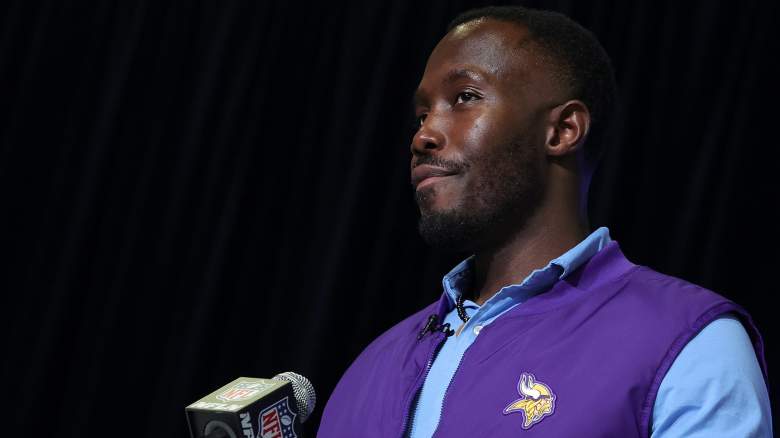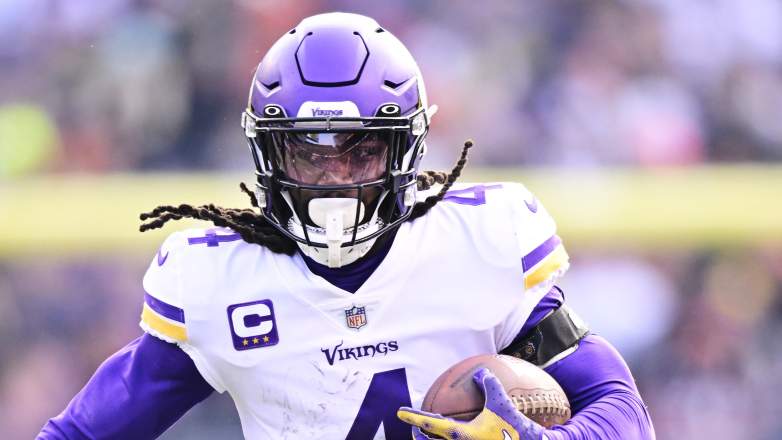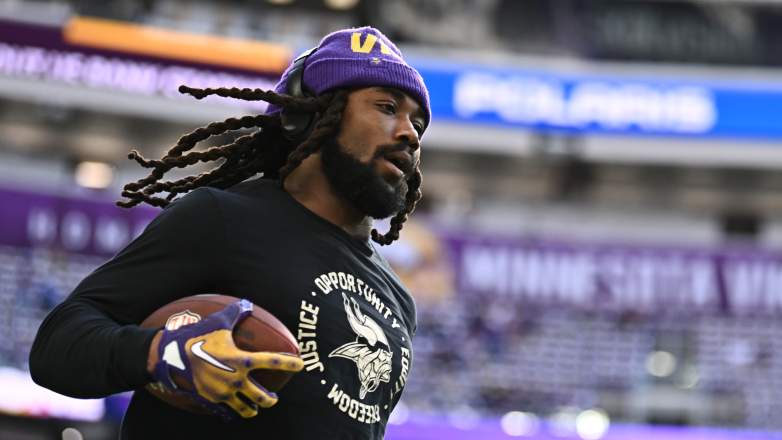
Getty General Manager Kwesi Adofo-Mensah of the Minnesota Vikings speaks to the media during the NFL Combine at the Indiana Convention Center in February 2023.
The Minnesota Vikings have made several brutal decisions this offseason leading to the exits of long-time fan favorites, and another appears to be coming soon.
Running back Dalvin Cook represents the antithesis of everything Kwesi Adofo-Mensah believes as a general manager who rose to the position through the analytics departments of various NFL organizations — a player with an above-market contract at perhaps the least valuable position on the roster. Cook will enter the third season of a five-year deal worth $63 million in 2023 and is set to cost $14.1 million against the Vikings’ salary cap. For a team remaking itself with young talent on inexpensive deals, the four-time Pro-Bowl running back is an obvious man out.
Minnesota has attempted to meet Cook in the middle, asking him to come to the table and work out a compromise on a contract restructure that would decrease his overall pay. To this point, Cook has declined. The stalemate is one that ESPN’s Kevin Seifert contended can’t last much longer in a report authored on March 31.
“The Vikings haven’t yet offered a public explanation of why they re-signed [Alexander] Mattison with Cook still on the roster, and that’s not an accident,” Seifert wrote. “Based on everything that we’ve seen, and what has gone unsaid, it’s almost impossible to believe that Cook will remain on the roster at his current numbers. He’ll either accept a significant pay cut, get traded or be released.”
Money, Injuries Complicate Vikings’ Trade Market For Cook

GettyRunning back Dalvin Cook of the Minnesota Vikings carries the ball during a game against the Chicago Bears at Soldier Field on January 8, 2023 in Chicago, Illinois. (Photo by Quinn Harris/Getty Images)
The ideal situation for the Vikings is Cook accepting a pay cut, but he has made it clear that is a non-starter.
The next best outcome for the franchise is a trade, in which there has been some interest from at least one team. The Miami Dolphins inquired about Cook’s availability, per a report last week from Barry Jackson of the Miami Herald.
But Cook’s contract is going to be difficult to deal. The running back will play next season, his seventh in the NFL, at the age of 28. He is owed $37 million in total payment and represents a cap hit to the Vikings of more than $43 million over that span. Trades for players who are mid-contract often result in reworked agreements that can bring down the initial financial hit and annual numbers, but tend to do so in favor of more money overall across a longer life of contract.
In other words, if the Dolphins or any other team want to trade for Cook, it is probably going to cost them more than $37 million in the long run as they commit to a running back with a significant injury history well into his early 30s.
NFL Network’s Tom Pelissero reported on Monday, April 3, that Cook has made “excellent progress” following offseason shoulder surgery that he underwent to fix an ailment that has dogged the Vikings running back for the last three years.
While the injury news is good, that Cook needed surgery at all is a red flag for any franchise ready to commit eight-figures annually to a running back approaching the age-30 threshold — a point at which so many who have played the position began precipitous declines in both health and production.
Vikings Can Save Millions by Parting Ways With Cook Ahead of Season

GettyRunning back Dalvin Cook of the Minnesota Vikings warms up prior to the NFC Wild Card Playoff Game against the New York Giants at U.S. Bank Stadium on January 15, 2023 in Minneapolis, Minnesota. (Photo by Stephen Maturen/Getty Images)
At this point, getting anything in return for Cook in a deal would be a win for the Vikings considering the contract and risk that any trade partner would be assuming.
A mid- or late-round pick, in the range of a fourth or a fifth, would prove ideal. That is true not only because it would be a return for a player who, if healthy, does retain real value to a contender, but also because it would bring significant cap savings to Minnesota’s balance sheet.
The Vikings will save roughly $7.9 million if they trade Cook before June 1. That number jumps to $11 million if they trade him after that date, per Over The Cap. On the other hand, cutting Cook prior to June 1 will save Minnesota $5.9 million against the cap, while cutting him later than that will save the franchise $9 million.
In either case, it behooves the Vikings financially to wait until the summer to move on Cook. However, if they can trade him this month for a draft asset, the player they acquire via that pick can help the team this year.
As such, it seems to make sense for Minnesota to push for a trade ahead of draft night on April 27. But due to Cook’s injury status, the completion of a deal that soon could be complicated.
If the Vikings can’t trade Cook by then, which appears the most likely outcome, then the smartest play is to wait until June to make a move. If the team can find a trade for him then, that is still the best result. If not, the Vikings can cut ties with Cook and repurpose the $9 million they save to help the roster in some other fashion.